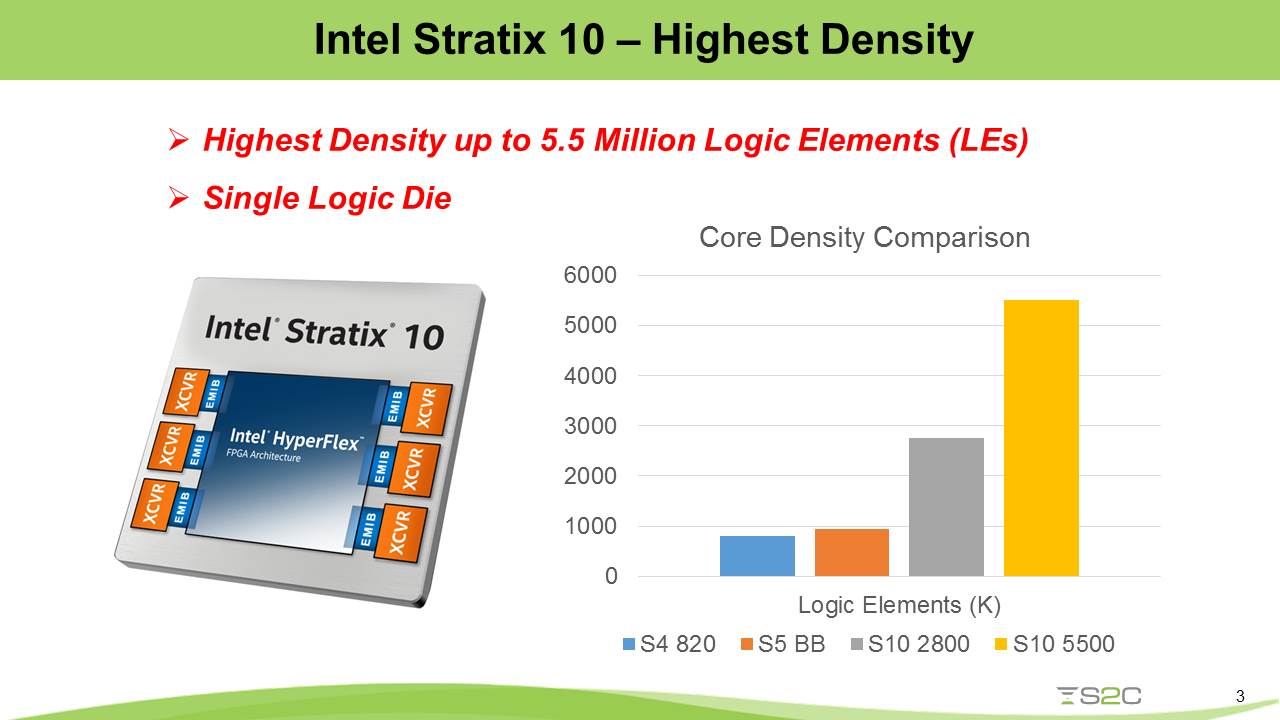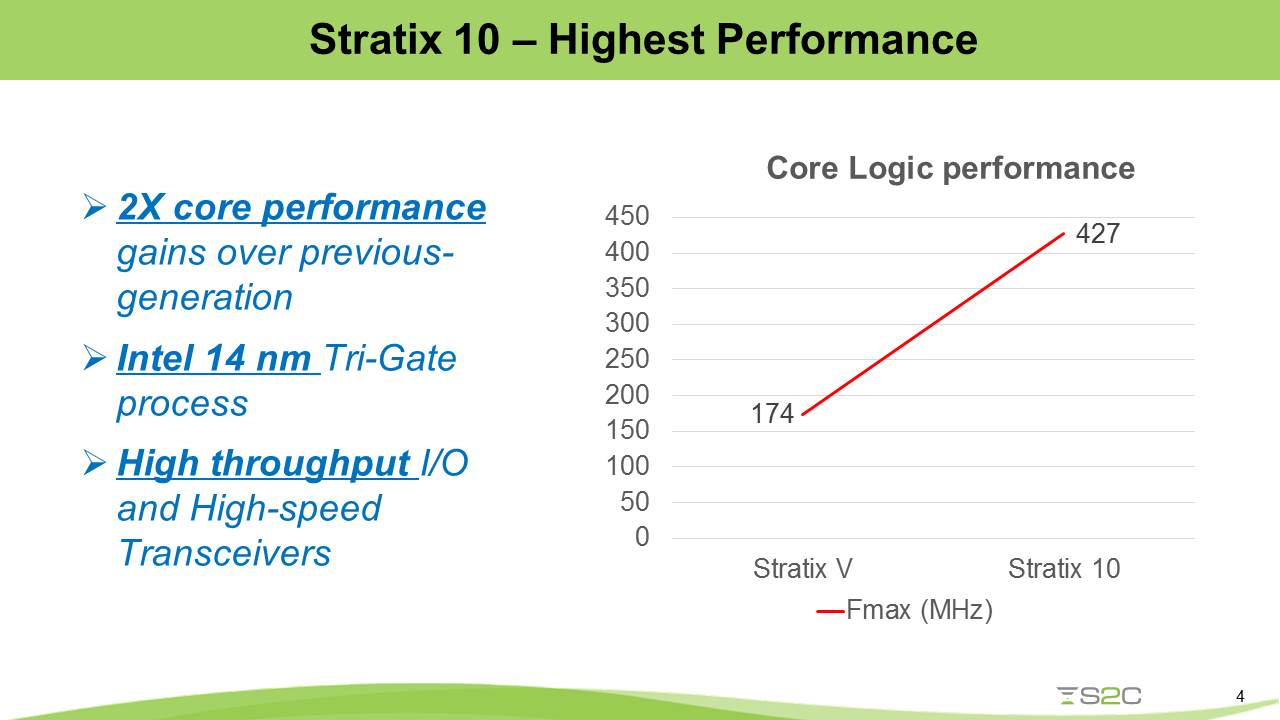Due to the overwhelming response, here is the first part of the webinar that I did with S2C and a link to the replay. Richard Chang, Vice President of Engineering at S2C did the technical part of the webinar. Richard has a Masters degree in Electrical engineering from the University at Buffalo and more than 20 years experience designing chips, including two US patents. Here is the agenda:
FPGAs have been used for ASIC prototyping since the beginning of FPGAs (1980s) allowing hardware and software designers to work in harmony developing, testing, and optimizing their products. The high density FPGA – Intel Stratix 10 and Arria 10 are available now with Stratix 10 FPGAs delivering breakthrough advantages in performance, density, and system integrations with single logic die using the Intel 14nm Tri-gate process. In this webinar, we will highlight the advantages of using Intel FPGAs for prototyping and walk through the implementation flow for both single and multi-FPGA boards.
- Stratix 10 & Arria 10 FPGA Highlights
- S2C S10 & A10 Prototyping Platforms
- Single FPGA Design and Debug Flow
- Multi-FPGA Design and Debug Flow
- Demonstration – Implementing DDR4
- Q&AIt really did bring me back to the good old Altera vs Xilinx days where they used to beat each other up and provide customers with the most cost competitive products. Based on what I have learned by working with S2C the past few months Intel/Altera is now superior to Xilinx for FPGA Prototyping, absolutely.Webinar:Intel’s latest Stratix-10 and Arria-10 FPGAs have considerably improved FPGA prototyping applications. Using the Intel 14nm process the Stratix-10 FPGA performance is more than twice the speed and capacity is more than five times larger than the previous generation. Today, we will start the webinar with highlights of Stratix-10 and Arria-10 features for FPGA prototyping. We will then introduce the new S2C Intel-based product line. We will also illustrate the compile flows for both single and multi FPGA designs. Finally, we will walk through a quick design implementation using a DDR4 reference design followed by questions and answers.

Intel is now shipping the production version of its flagship Stratix-10 FPGA 2800 devices. The 2800 is about 3 times the density of the stratix-5 generation which makes design fitting and partitioning much easier. In addition, the Intel Stratix-10 FPGA uses a single logic die architecture versus multiple dies which enables higher utilization and better performance. Intel is also planning to ship the Stratix-10 5500 device that will almost double the capacity of the 2800. Additionally, the 5500 will have a package footprint that allows easy upgrading from the 2800.

The Intel 14nm process also makes a big difference on performance. The maximum frequency has increased from 174MHz to 427MHz compared with the previous Stratix 5 generation. There’s also significant improvement on Stratix-10 FPGA I/O and high-speed transceivers. LVDS is now fully configurable and can run at 1.6GHz making pin-multiplexing between FPGAs more efficient. The high-speed transceivers can run at up to 58G – which is more than enough for most SoC Prototyping applications such as video streaming and high-speed data transfer.
The Arria-10 has most of the features of the Stratix-10 except it is smaller. The largest Arria-10 device the 1150 is about half the size of the Stratix-10 2800. With its attractive entry price point the 1150 is suitable for a variety of small to mid-sized IoT/SoC applications. The Arria-10 has abundant internal memories and lots of DSP cores. In fact, the DSP cores are the industry’s only hardened floating-point DSP blocks making the Arria-10 the top choice for computation intensive applications.
Many of today’s applications, such as AI, IoT, computer vision, and autonomous driving, requires intensive software and firmware development so having the ability to deploy an array of pre-silicon platforms for software development and compatibility testing dramatically increase the chance of a successful product launch. With affordable pricing, Arria-10 1150 FPGA is the ideal candidate for those applications.
Next I will introduce S2C’s complete FPGA prototyping solution for Stratix-10 and Arria-10 FPGA but first a quick overview of S2C. S2C is a worldwide leader in providing both hardware and software solutions for FPGA prototyping. The S2C 60+ member team is fully dedicated to delivering FPGA prototyping solutions and they have served over 400 customers in the past 15 years. S2C is headquartered in San Jose, CA with direct support centers in Shanghai, Beijing, Hsinchu, Shin-Yokohama and Seoul.
S2C offers a wide range of Intel Stratix-10 and Arria-10 based FPGA prototyping hardware. For the S10-series S2C offers Single, Dual, and Quad Prodigy Logic Modules that can go from 28M gates to 220M gates when the 5500 is available from Intel. The 2800 Dual and Single Prodigy Logic Module are shipping now and the 2800 Quad Prodigy Logic Module will be available in July. For smaller and medium sized designs, the A10-1150 is a good alternative with 2 form factors to choose from: standard expandable chassis with flexible I/O or the PCIe finger form factor.
The S10 and A10 Prodigy Logic Modules are S2C’s 6[SUP]th[/SUP] generation FPGA prototyping system that is easy to expand for different applications, scale for different design sizes, and are reusable for different projects. Next is a 1 minute video that highlights the key features of the new S10 and A10 Prodigy Logic Module chassis system…
Another key feature of S2C’s S10 and A10 FPGA prototyping systems is the many off-the-shelf daughter cards that are available. The use of daughter cards for FPGA prototyping is an important concept as it allows flexibility in case design specs change, expandability for design growth, and reusability for future designs.
S2C provides 80 different types of memory, interface, and accessory cards for customers to quickly put together prototyping platforms that closely resemble final products. Some examples are ARM processors, PCIe, Ethernet, USB, DDR4, Flash memories, HDMI, and many others.
S2C also provides daughter card design guidelines in case prefer to develop your own application daughter cards or if you choose not to build-your-own but still want a customized application specific daughter cards. S2C also provides daughter card design services.
Next Richard will explain the FPGA prototyping software flows for Intel Stratix-10 and Arria-10 FPGAs….






Comments
There are no comments yet.
You must register or log in to view/post comments.